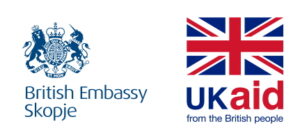Elena Gagovska
 The fact that the case (“Public Room”) remained unresolved almost two years after it was discovered activates the public because the illusion that the authorities are working on the case is shattered.
The fact that the case (“Public Room”) remained unresolved almost two years after it was discovered activates the public because the illusion that the authorities are working on the case is shattered.
Gender-based violence is one of the several forms of violence where guilt is often sought within the victim. In other words, girls and women who are the most common victims of this type of violence are often presented in social discourses and by the media as partly or completely to blame for what happened to them. This accusation of the gender-based violence victims is the result of the sexist matrices and patriarchal values that justify sexual violence and view the victims with suspicion because of their gender.
The scandalous sharing of explicit content
“Public Room” was a chat group with thousands of (male) members of the encrypted Telegram application that first appeared in 2020 and then reappeared in 2021, in which private photos and videos with explicit and pornographic content, social media profiles, telephone numbers, and other personal data of women and girls from Macedonia were shared without their consent. In November 2021 a report was published on the media coverage of topics related to the LGBTI community and gender-based violence. Part of the report was a case study about the “Public Room” in which I made a comparative analysis of the media coverage of “Public Room” in 2020 and in 2021.
Public Room was a crime and a huge scandal about gender-based violence, but not everyone perceived the case as such. The social media were full of problematic narratives condemning the victims of the “Public Room” for the way they photographed themselves, the way they posted their pictures, why they had open-type Instagram profiles, etc. In other words, many blamed the victims for being victims and the media coverage of the case often did not help to dispel these harmful narratives.
Media sensationalism
In 2020 there is a domination of narratives that implicitly blame the victims, by not using the accurate terminology that defines the activities in that group as crimes, nor are there clear boundaries as to who the perpetrator is and who the victim is. Instead, in 2020 many of the articles rely on sensationalism and capitalize on the social taboo about sex and pornography. This means that the 2020 articles lack terminology such as “gender-based violence”, “sexual harassment”, or the fact that the materials were shared without the consent of the victims. Very often, even the word “victim” is absent from these articles, while the focus is on the scandal of the case.
The 2020 articles also focus on the juvenile victims and the child pornography shared in the group, almost ignoring the adult victims and the victims who only had their personal data misused. The absence of the voices of the victims is also noticeable. Because in 2020 the gender component of the violence is generally not mentioned and there is no clear line between who the perpetrators are and who the victims are, the media provide moralistic and ahistorical explanations for the alleged deviance of the young generations as the reason for the emergence of the “Public Room”.
There are two intertwined narratives that explain this alleged deviance, with more emphasis generally placed on the latter: (1) the uncontrolled use of social media among young people, and (2) a lack of family values. Instead of finding systemic solutions to this serious type of violence and demanding appropriate action by the Government institutions, many articles blame the parents i.e. the blame is placed on the private sphere of the family. An example that perfectly illustrates these moralizing narratives is the interview published in “Women Magazine” with the pedagogue Vesna Velkova. When asked for a recommendation on how to “protect young people from ending up in another ‘public room?’”, she says:
“If you ask me, telephones in schools should be banned by law, even though we have places where they leave them. My message is to the parents. Build strong foundations in the family so that we, in the schools, can build floors on top of that foundation. From my experience, I want to say only one thing to the parents. The children demand attention – everything else is less important to them.”
 Source: licevlice.mk
Source: licevlice.mk
Evolution of media narratives in 2021
Unlike 2020, in 2021 the blame for the “Public Room” is not in the private sphere, but in the public sphere and the competent Government institutions. The narrative that implicitly accuses victims is almost non-existent in 2021 because girls and women whose images or personal information have been misused are properly framed as victims. Although it must be noted that, in addition to the inclusion of the word “victim”, the media in 2021 again rarely use other relevant terms, such as “gender-based violence”. This positive change in the reporting relies on the anonymous and public statements of some of the adult victims in the “Public Room”.
In 2021, in the first text about the new “Public Room”, the voice of one of the victims is now heard i.e. there is a statement of an anonymous 22-year old girl who got in touch with the Sitel TV editorial office. The same article includes a quote from an expert from the civil sector, Irena Cvetkovikj, the executive director of the “Margini” Coalition, who correctly identifies the victims of the “Public Room” as victims and designates the activities in the Telegram group as a crime. In 2021 there have been few articles that moralize or sensationalize the case (although they do exist) because the focus is on the voices of the victims, the activists, and the civil sector.
By giving an opportunity to people like Ana Koleva, a 28-year old girl from Kavadarci and a victim of the “Public Room”, who spoke publicly about her experience, the media implicitly sided with the victims. In 2020, by ignoring the gender component of the violence and framing the “Public Room” as a problem of the young people that was happened due to a "lack of family values", the media subtly shift some of the blame on the victims.
However, in 2021, when victims like Ana Koleva and lawyer Marta Gusar are interviewed by the media, a clearer narrative is presented to the audience in which the perpetrators are the ones who were sharing the pictures/ personal data and sexually harassed the victims, while victims are the ones who experienced this type of cyberbullying. It is also a positive thing that in 2021, in addition to condemning the behavior of the perpetrators, the Government institutions that do not act and do not protect victims are also condemned.
A positive example that includes the voices of the victims and the civil society is the article by Republika about the “Public Room” protest held on February 03 under the heading “Violence against women is not a personal problem of every woman, but an obligation of the institutions“. With such a heading, this article emphasizes that this type of violence is a systemic problem and points the blame on the inactive state institutions, instead of condemning the individual behavior of the women victims:
More than 500 citizens protested under the slogan “Public Room is a crime” at yesterday's march organized by the Platform for Gender Equality, expressing disappointment with the system and the inaction of the institutions in the “Public Room” case, which is a crime in which countless women are victims of gender-based violence.
An important role in creating this narrative that seeks guilt and responsibility in the public sphere has the time factor i.e. the fact that the “Public Room” is re-introduced for the second time without any person being responsible for the crimes committed. The fact that the case remained unresolved only a year after it was discovered activates the public because the illusion that the authorities are working on the case is shattered.
It must be noted that the public expression of the revolt over the case that was expressed through the civil protests on February 3 and March 8, the guerrilla actions, as well as press conferences of the Gender Equality Platform aimed at the Ministry of Interior and the Public Prosecutor’s Office - which received adequate media attention - also contributes to the creation of a media narrative that targets the state institutions rather than the family.
Although there are huge improvements in the way of reporting in 2021 with avoiding moralizing narratives, giving of an opportunity to the activists and victims, and generally blaming the public sphere, still the journalists and the media workers do not pay enough attention to the terminology they use in the discussions on the gender-based violence and sexual harassment. It is certainly positive that in 2021, the media implicitly sided with the victims, but I think there is a missed opportunity to educate the general public about gender-based violence as a systemic problem stemming from sexist and patriarchal values.
If a broader context was given in each “Public Room” media report that focused on the gender component of this violence and precise terminology was used, such as gender-based violence, in order to define exactly what happened in this Telegram group, I believe that some of the harmful discourses that blamed the victims and flooded the social media could have been prevented.
With the use of accurate terminology, the media could have much more clearly framed the “Public Room” case as a symptom of a systemic problem of gender-based violence stemming from deep-seated sexist and patriarchal values that permeate all spheres of our society. That is, through such framing, many people who consume media content could have been at least partially acquainted with these topics and sympathize not only with the victims of the “Public Room”, but also with future victims of gender-based violence.
Please refer to the Terms before commenting and republishing the content.
Note: The views and opinions expressed in this article are those of the author and do not necessarily reflect the views of the Institute of Communication Studies or the donor.


